The Best Places to Visit in the Moselle Valley
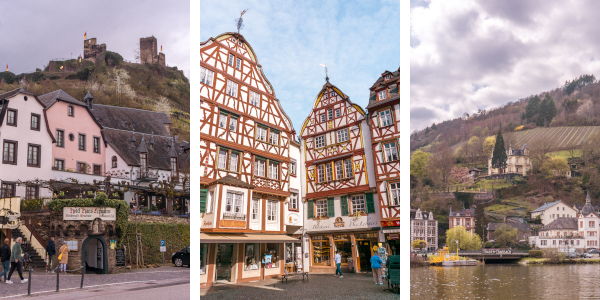
A 3-Day Itinerary in the Moselle Valley
Nestled within the embrace of rolling vineyards and framed by the meandering Moselle River, the romantic Moselle Valley has a lot to offer. From charming medieval villages with its, often ruined, castles to beautiful viewpoints overlooking the river, you can definitely see why this area of Germany has inspired poets and artists for centuries. Beyond the more famous towns along the river, such as Cochem and Bernkastel-Kues, we’ve also visited the lesser-known towns such as Beilstein and Traben-Trarbach. We even made a trip to the nearby, but not located along the river, Burg Eltz and Monreal, places we can highly recommend visiting. In this blog post, we’re sharing our 3-day itinerary in the Moselle Valley, so you’re fully prepared for your visit to this area.
Day 1
Cochem
Cochem is one of the larger and best known towns along the Moselle River. With Cochem Castle perched atop a hill, cobblestone streets, and the colorful half-timbered buildings, Cochem looks like a town coming straight from a fairy-tale. You basically can’t miss visiting Cochem when you’re in the Moselle Valley.
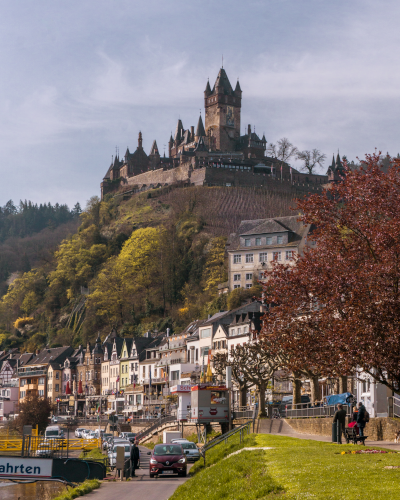
Cochem
Of course, a visit to Cochem Castle is a must in Cochem. Cochem Castle is unique in the Moselle Valley, as it’s one of the few castles (if not the only one) that isn’t a ruin. You can only visit the castle on a guided tour. The tour guide shares the history of the castle and shows you around a few rooms, such as the dining hall, the weapon room and the balcony.
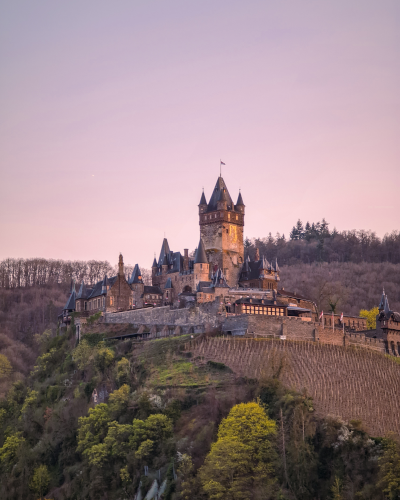
Cochem Castle
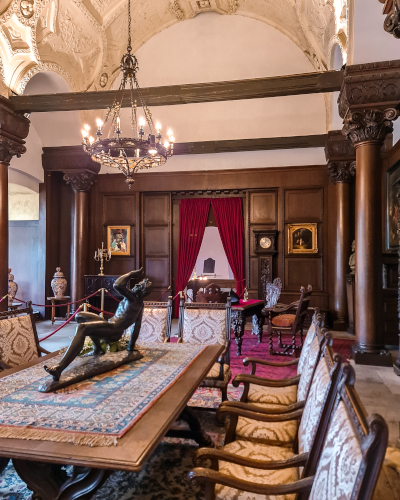
Tour in Cochem Castle
When you’re done visiting Cochem Castle, head back down to Marktplatz (Market Square) in the historic town center. Marktplatz is surrounded by charming half-timbered houses. The fountain and statue in the middle of Marktplatz, Martinsbrunnen, depicts the image of Saint Martin sharing his cloak with a beggar while being on the back of a horse. The large building on the north side of the square is the Rathaus (Town Hall), dating back to 1739.
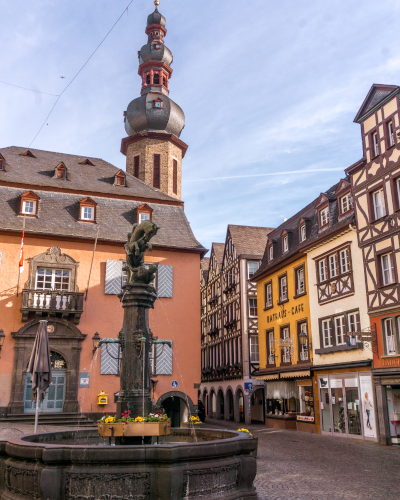
Marktplatz in Cochem
Don’t forget to stroll along the banks of the river and cross the Skagerak-Brücke for the best view of Cochem from across the water. This view is especially beautiful during golden hour.
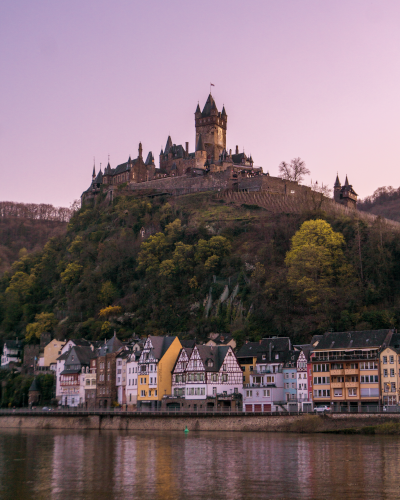
Cochem from across the river
Another fun thing to do in Cochem is going up the Sesselbahn (chairlift). The top station of the chairlift offers incredible views of Cochem and the surrounding. There’s also a café where you can have a drink or small bite while looking at the view.
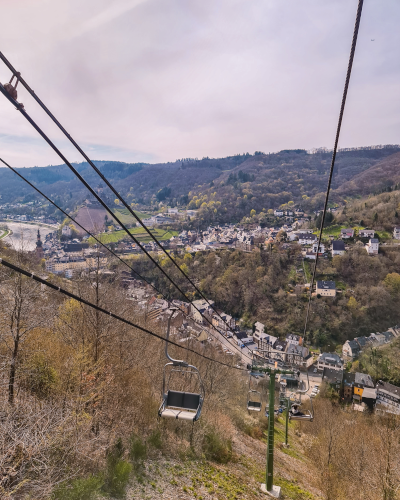
Cochemer Sesselbahn
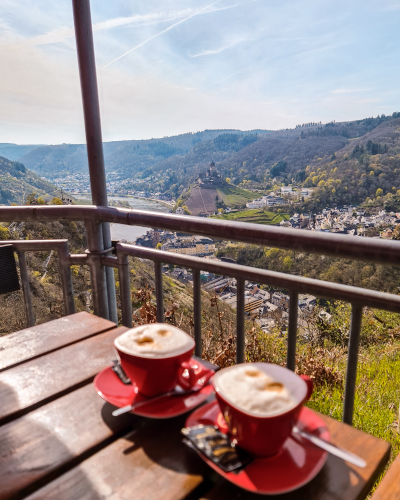
Café at the top station of the Cochemer Sesselbahn
Make sure to check out our sightseeing guide of Cochem, for more in-depth information about the best things to do in this enchanting town.
Day 2
Burg Eltz
Burg Eltz actually isn’t located along the Moselle River, but with only a 30-minute drive from Cochem, it’s very nearby. Burg Eltz was one of those places that was high on our bucket list for a long time and we were glad we could finally visit this magical castle. Since Burg Eltz is a very popular tourist attraction, we’d recommend visiting the castle in the morning to avoid long waiting times at the ticket office. You can only visit Burg Eltz with a tour guide and you aren’t allowed to roam around the castle by yourself. An entrance ticket is €14 per person and includes a tour through the castle and a visit to the treasury. Tours are offered in English and German.
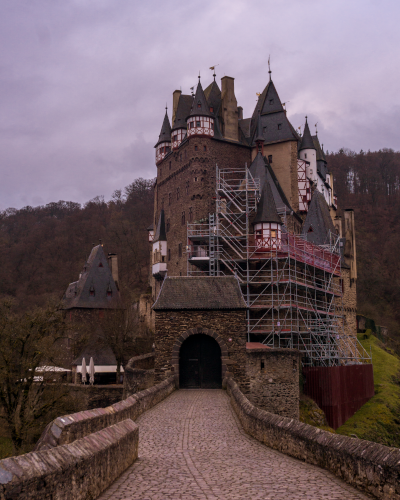
Burg Eltz
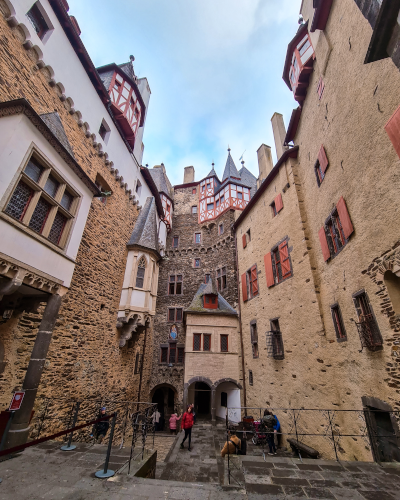
Courtyard of Burg Eltz
In this blog post we’re sharing everything you need to know about visiting and taking photos of Burg Eltz, so be sure to read it if you’re planning on visiting!
Opening hours
Daily from 09:30 until 18:00
Burg Eltz is open from April 1st until November 1st.
Monreal
While Burg Eltz is close enough to the Moselle River that it could be considered part of the Moselle Valley, Monreal absolutely isn’t. Despite that, it’s only a 30-minute drive from Cochem so you could easily visit the village when staying in the Moselle Valley. The tiny village of Monreal is located along the Elzbach River and has less than 800 inhabitants. Despite the small size of the village, Monreal is full of charm. The village is filled with well-preserved medieval half-timbered houses. We’d recommend wandering through the small cobblestone street and admire all the surrounding beauty. Don’t forget to stop at the Johannesbrücke for a beautiful view of Elzbach surrounded by the charming houses. As it’s such a small village, you only need a few hours to explore every inch of it.
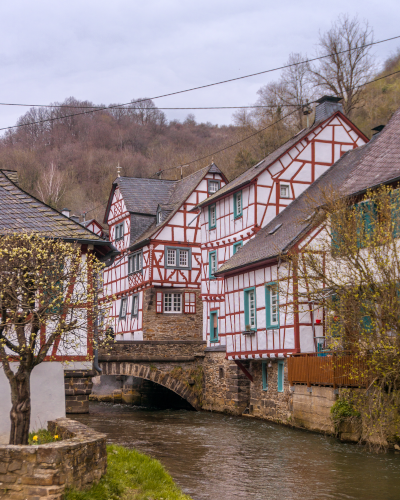
Half-timbered houses in Monreal
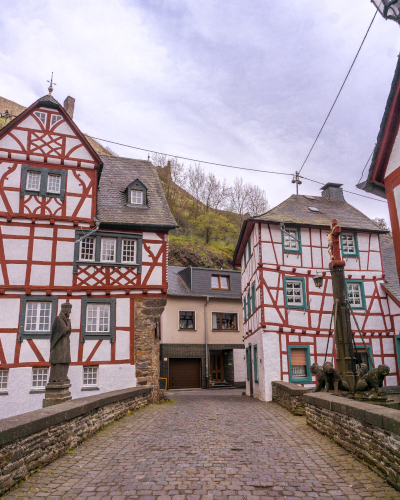
Johannesbrücke in Monreal
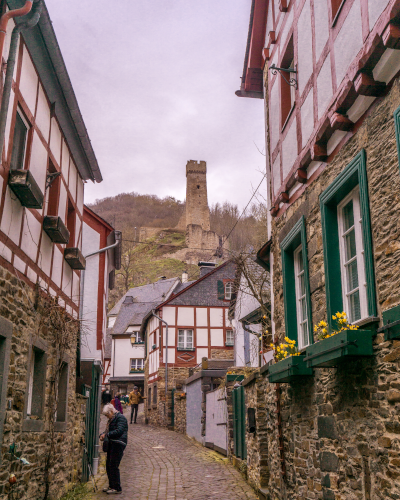
View of Philippsburg from the village
Despite its small size, Monreal has two ruined hill castles: Löwenburg and Philippsburg. Both castles date back to the 13th century. In 1632, the castles were heavily damaged by the Swedish troops and in 1689, they were completely destroyed by the French. Both ruins are open to visitors. As both castles are built on top of a hill, the view from up there is amazing. You can even climb the tower of Löwenburg for an even better view of the surroundings. There’s no entrance fee to the ruins and you can visit them at any time of the day. You can reach the ruins after a short, but steep, hike from the village’s center.
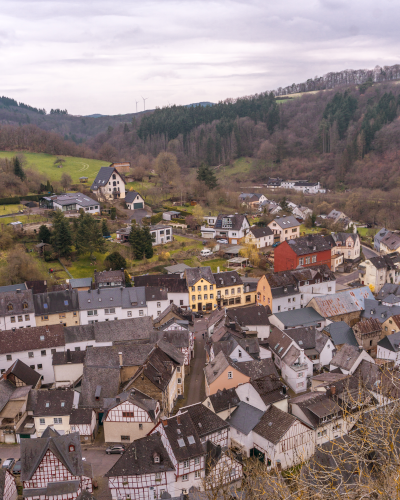
View of Monreal from Löwenburg
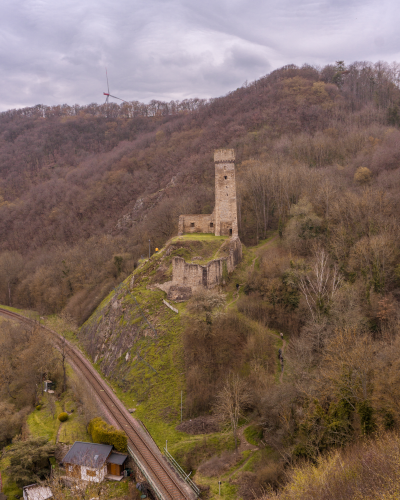
View of Philippsburg from Löwenburg
You can access Philippsburg and Löwenburg 24 hours a day and there’s no entrance fee.
Beilstein
In our opinion, Beilstein is the most charming town along the Moselle River. The buildings are well-preserved and it’s not too touristy. There are also plenty of restaurants with outdoor seating areas that look very nice. Unfortunately, we thought it was way too cold to sit outside when we were in Beilstein. But we bet it’s very nice when the temperatures are above 15 degrees Celsius. Nevertheless whether it’s cold or warm outside, we think you can’t miss visiting Beilstein when in the Moselle Valley.
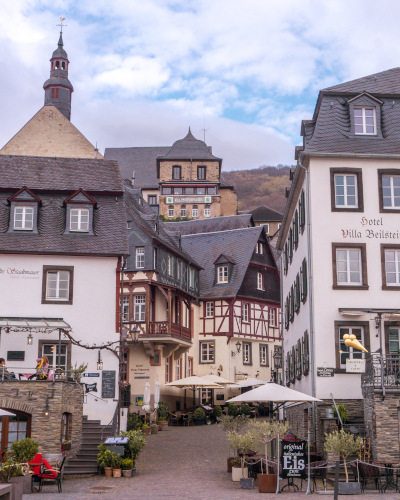
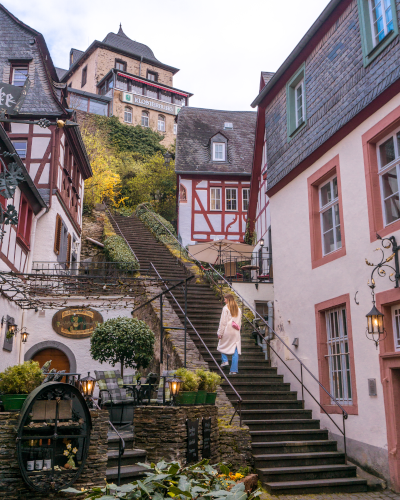
Charming town of Beilstein
Beilstein is home to Burg Metternich, a ruined castle from the Middle Ages. Burg Metternich was first mentioned in 1268, but historians think the castle was already built in 1129. During the Nine Years’ War, the French troops destroyed Burg Metternich and it hasn’t been rebuilt since. It’s possible to visit the ruined castle and walk around the grounds. There’s a restaurant in Burg Metternich with an outdoor seating area that offers amazing views of the surroundings. As mentioned before, we thought it was way too cold to sit outside when we were there, so we just enjoyed the views while walking around.
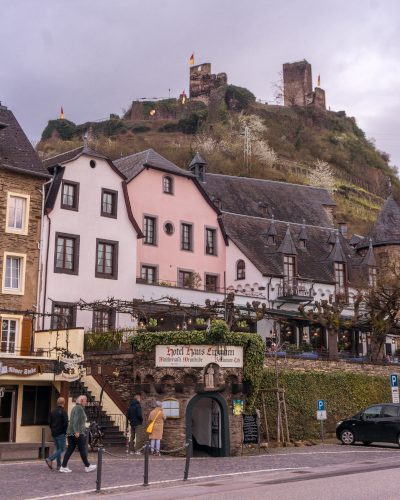
Charming houses of Beilstein and Burg Metternich in the background
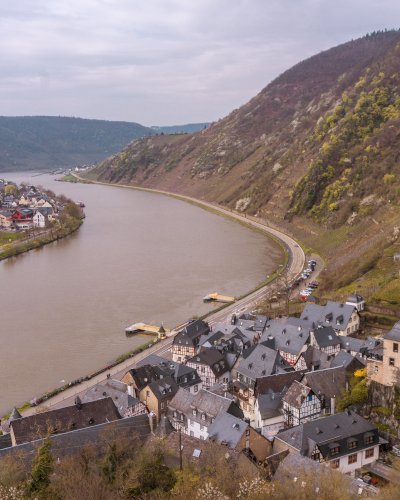
View of Beilstein and the Moselle River from Burg Metternich
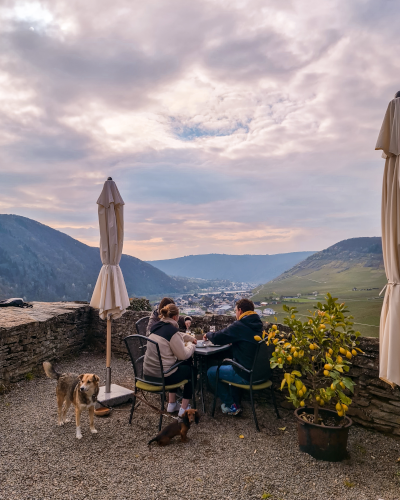
Outdoor seating area of the restaurant in Burg Metternich
Opening hours of Burg Metternich
Daily from 10:00 until 18:00
Closed from November until March
The entrance fee is €3.
Day 3
Bernkastel-Kues
Just like Cochem, Bernkastel-Kues is one of the most popular places to visit in the Moselle Valley. In Bernkastel-Kues you can find colorful half-timbered medieval buildings in the architecture style that’s typical for the Moselle Valley. There are plenty of restaurants, cafés and (souvenir) shops in town. Since there’s a river cruise dock in Bernkastel-Kues, the town gets very crowded during the day with cruise tourists, as well as day trip tourists. Therefore, we’d recommend Bernkastel-Kues early in the morning.
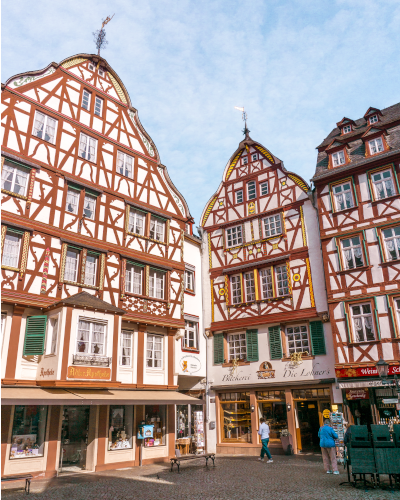
Half-timbered houses in Bernkastel-Kues
When roaming through the town, you can’t miss paying a visit to the iconic Marktplatz. This former marketplace is surrounded by the typical half-timbered houses that date back to the 17th century. In the center of the Marktplatz stands the Michaelsbrunnen, a fountain dating back to 1606. South-east of the square you can find the Old Town Hall (Rathaus) which dates back to 1608 and nowadays houses a restaurant.
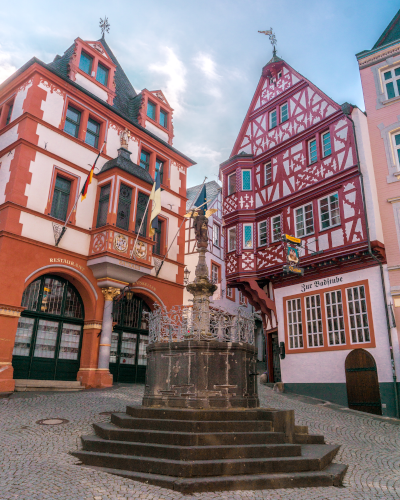
Michaelsbrunnen and the Old Town Hall on the left
The pink building on the south end of the square got our (read: Mika’s) attention. It happened to be a konditorei (pastry shop) with a seating area in the back. We decided to head in for a second breakfast consisting of coffee and cake.
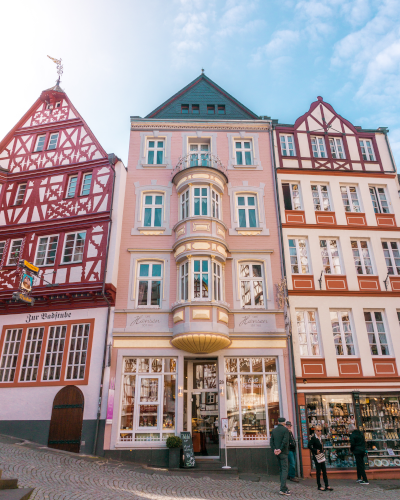
Café Hansen
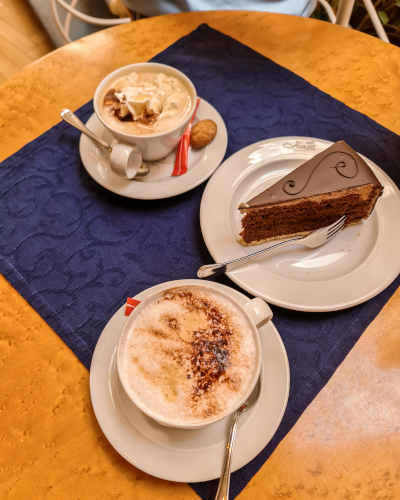
Coffee and Sachertorte, which is actually from Vienna but tastes good in Bernkastel-Kues as well
Of course, a town in the Moselle Valley isn’t complete without a (ruined) castle on top of the nearest hill. The castle in Bernkastel-Kues is called Burg Landshut. The oldest fortifications on the site on which Burg Landshut stands today date back to the 4th century. The current hilltop castle was built at the end of the 13th century. Burg Landshut was destroyed by a fire in 1692 and was never rebuilt. Nowadays, there’s a restaurant inside the ruins with large windows overlooking the Moselle River. Because of the beautiful views, it’s a popular restaurant. We’d recommend making a reservation in advance, especially if you want to sit right next to the window. Unfortunately, we didn’t make a reservation and were unable to get a table next to the window during lunch time.
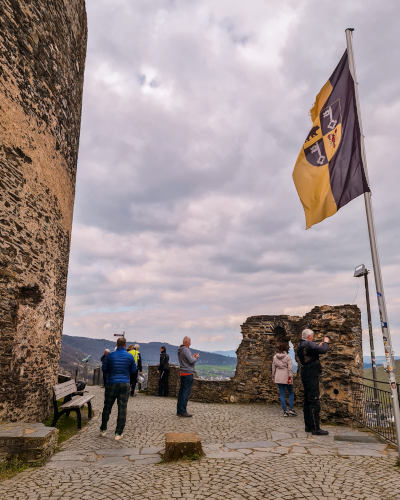
Burg Landshut
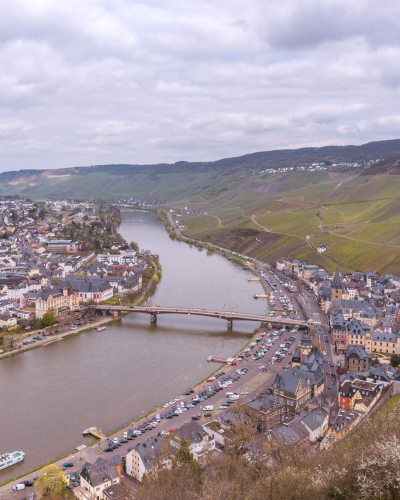
View from Burg Landshut of Bernkastel-Kues and the Moselle River
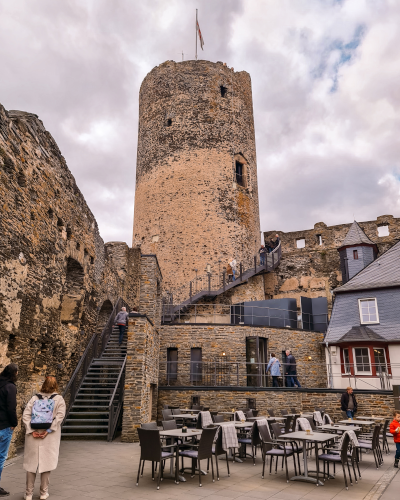
Courtyard of Burg Landshut
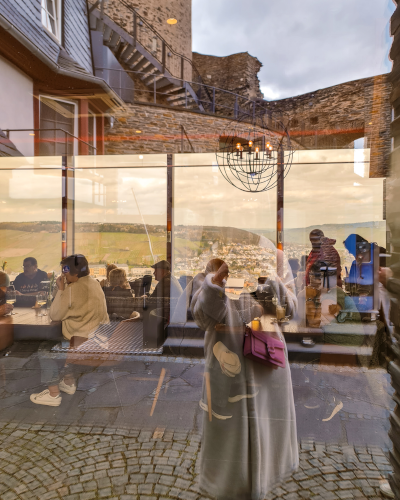
Restaurant in Burg Landshut with large windows overlooking Bernkastel-Kues and the Moselle River
Opening hours of Burg Landshut
Daily from 11:00 until 21:00
Closed on Wednesdays
There is no entrance fee.
Traben-Trarbach
Traben, north of the river, and Trarbach, south of the river, used to be two separate towns divided by the Moselle River. In 1898, the first bridge was built between the two towns. It was also the first bridge in the area between the banks of the river. The next bridges in the Moselle Valley were only built in 1924 (in Cochem) and between 1951 and 1953 (in Zell). The late 19th and early 20th centuries marked a period of prosperity for Traben-Trarbach. The town embraced Jugendstil, the German Art Nouveau movement, resulting in an architectural landscape adorned with ornate facades, wrought-iron balconies, and beautiful details. When wandering around the town, you’ll stumble upon many buildings with Art Nouveau facades. Even the lettering on most buildings is in an Art Nouveau font. Traben-Trarbach is a peaceful town and we loved strolling through its streets and along the banks of the Moselle River.
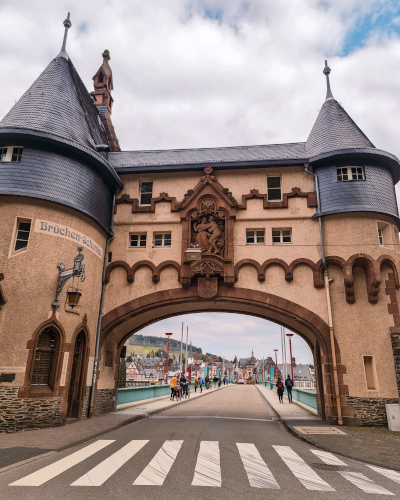
Brückentor in Trarbach
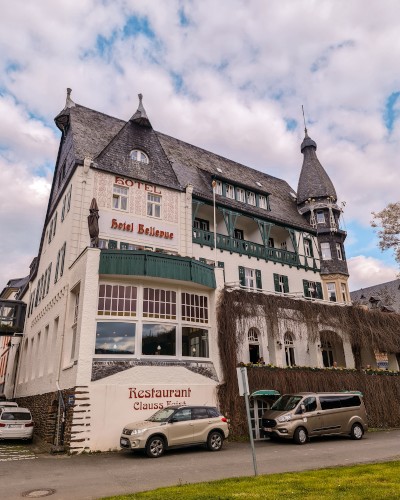
Art Nouveau Hotel Bellevue in Traben
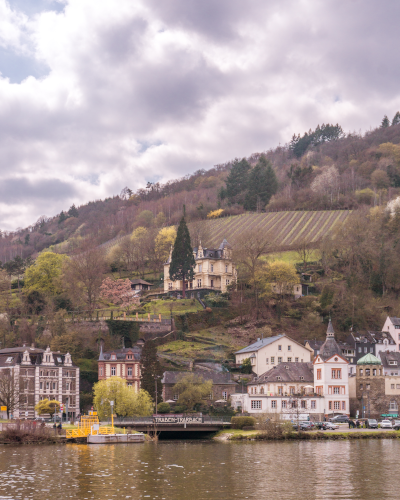
View of Trarbach from Traben
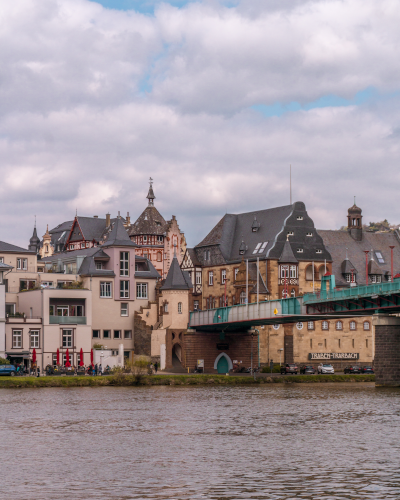
View of Traben from Trarbach
Grevenburg is the ruined castle of Traben-Trarbach, located in the Trarbach part of town. The castle was built in 1350 and was destroyed and rebuilt several times. In 1734, the French destroyed the castle for the last time and it hasn’t been rebuilt since then. Only one outer wall remains standing today. You can walk up the ruins from the town and overlook Traben-Trarbach and the surroundings from above. We didn’t do the hike up the hill as it looked quite steep and by the time we were in Traben-Trarbach, our legs were so sore from climbing up to all the castles all weekend.
You can access Grevenburg 24 hours a day and there’s no entrance fee.
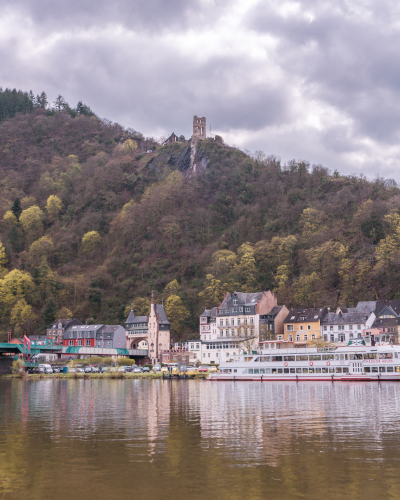
Grevenburg seen from across the river
Moselschleife Kröv - Wolf viewpoint
Along the Moselle River, you can find multiple viewpoints overlooking the river and the landscape. One of these viewpoints is just a 10-minute drive from Traben-Trarbach. We especially loved this viewpoint as the river meanders into a horseshoe bend. We parked the car at the visitors parking of the nearby Landal holiday park Mont Royal and walked to the viewpoint from there. If you have some more time, it’s also a great starting point for some hikes in the area.
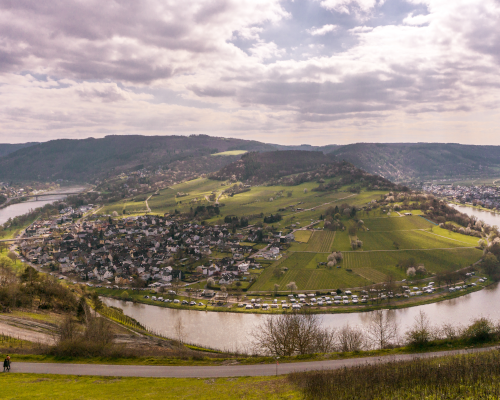
Horseshoe bend view of the Moselle River
Zell
Zell is mostly known for its wine and is the biggest winegrowing center in the Moselle Valley. There are 331 hectares of vineyards, mostly growing the Riesling grape. On the small market square in Zell, you’ll notice a fountain with a spitting cat on top of a wine barrel. According to the legend of the Zeller Schwarze Katz, two wine merchants in 1863 tried different barrels of wine but couldn’t decide which wine they wanted to buy. Eventually, they thought about putting off the decisions as they were pretty drunk, but then a black cat leaped onto one of the barrels and spat at anyone that came closer. The merchants decided to buy the entire stock of this wine. This story made Zell and its wine renowned around the world.
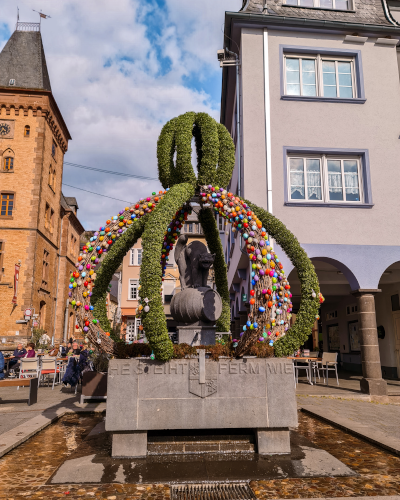
Black Cat Fountain
To be honest, Zell was our least favorite place along the Moselle River. For us, it felt like Zell didn’t have much charm, but we had been so spoiled already with all the other well-preserved medieval towns and villages. We did enjoy a nice affogato in an Eis Café. There are actually so many ice cafés in the Moselle Valley and they all have a very extensive ice cream menu. Especially spaghetti ice cream seems to be a favorite in this part of Germany. In the ice cream café we visited in Zell, they had a dedicated menu for spaghetti ice cream. So if you’re into spaghetti ice cream, we guess Zell is a must-visit. If you’re not and you’re short on time during your visit in the Moselle Valley, we’d say you could skip Zell. Unless you’re a wine-lover and you’re visiting the region for its wines. In that case we could understand that Zell is a must-visit. We wouldn’t know however, as we don’t really like wine.
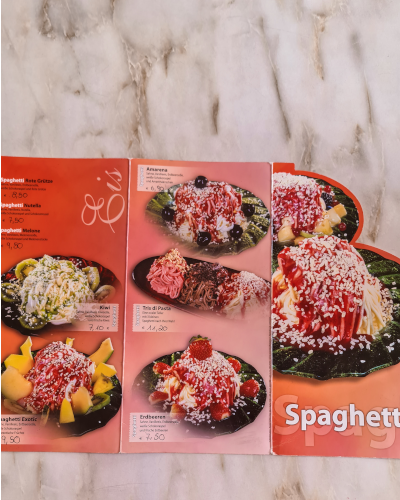
Menu filled with different kinds of spaghetti ice cream
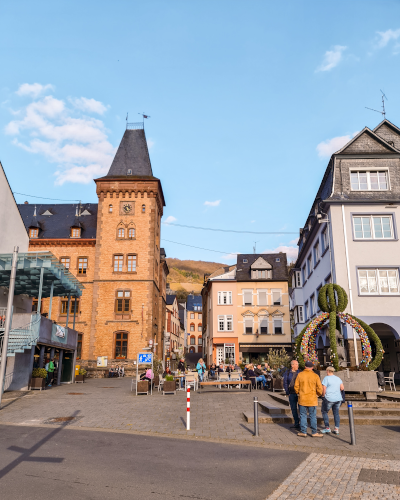
Zell
Where to stay in the Moselle Valley
We chose Cochem as our base to explore the above-listed town, because it’s one of the bigger towns along the river and therefore has enough diversity of restaurants, compared to the smaller towns that only have a handful of restaurants and often require reservations on the weekend. Unlike smaller places along the Moselle River, Cochem also has restaurants with different cuisines other than German. As we’re not the biggest fans of German cuisine, this was great for us. Cochem is also centrally located among the places we visited.
We booked a room in Gartenstudio Anila through booking. The room we booked was reasonably priced with parking included and you only had to cross the bridge to get to the center of Cochem. Unfortunately, the host had to cancel our booking on the day we arrived due to water damage. Fortunately, the host arranged a room for us in Pension Dapper, also with parking included as well as breakfast. The room in Pension Dapper was large with a private bathroom and had everything we needed for our stay over the weekend. We could park the car right in front of the pension, which was perfect. It was a pleasant 10-minute walk along the river to Cochem’s Marktplatz, right in the heart of the town’s center. We had a great stay at Pension Dapper and appreciated how prompt and well the host of Gartenstudio Anila arranged accommodation for us.
If you’re not traveling by car, consider staying right inside the town center. Most of the hotels in Cochem are located along the river and offer river views. However, Cochem is very small so even if you’re staying outside of the town center, it’s still probably less than a 10-minute walk to get into town. Staying in Cochem allowed us to explore the historic town early in the morning before the tourists flooded in.
Click here for more accommodation options in Cochem.
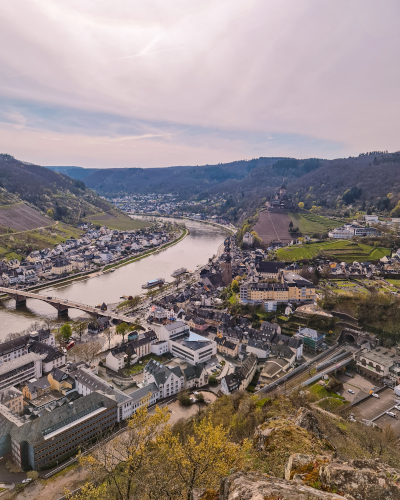
Cochem
Getting around the Moselle Valley
By public transport
Getting around the Moselle Valley by public transport is possible, but not ideal. Many of the towns along the river have a train station and/or bus station, but getting from one point to another by public transport can take a long time. For instance, it takes 2,5-hours to get to Monreal by public transport from Cochem, whereas it’s just a 30-minute drive. It simply takes (a lot) longer, so take this into consideration. Keep in mind that many of the bus lines don’t run between November and March. If you’re planning on getting around by public transport, it’s best to avoid those months.
By car
The most convenient way of getting around the Moselle Valley is by car. With a car you’re able to visit any place and town along the river at any time you like. This way you’re completely independent. Parking can be an issue though, as the towns are small and there aren’t always lots of parking places available. When we were in the Moselle Valley during the Easter weekend of 2023, we didn’t run into any parking issues. In our experience, it’s always possible to find a parking spot. Worst case scenario, you have to walk a little further to the town’s center. Keep in mind that it’s paid parking everywhere. If you’re traveling by car we’d recommend looking for a hotel or Airbnb with private parking so you can always park nearby the place you’re staying at.
By river cruise
Another means of transport to explore the Moselle Valley is by river cruise. There are a few river cruise companies offering multiple-day cruises along the Moselle River. A typical river cruise lasts 8 days and stops in Cochem, Trier, Bernkastel and Koblenz. Most of the time you’re staying less than a day in each town, so it’s just a quick visit to see the town’s highlights. Since the towns aren’t big, this isn’t a problem. However, most river cruises skip the smaller towns, such as Beilstein and Traben-Trarbach. It’s also not possible to visit Burg Eltz and Monreal during a river cruise as these places aren’t located along the river. Nevertheless, we bet it’s a fun experience.
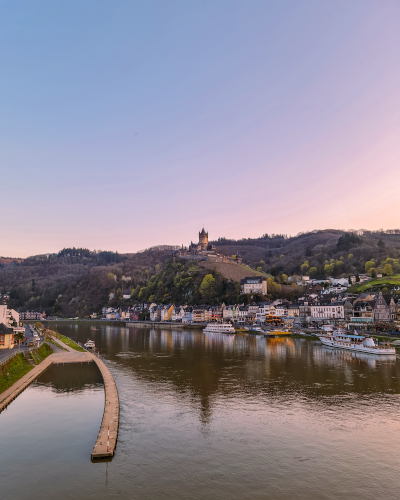
Cochem
How long to stay in the Moselle Valley
We stayed in the Moselle Valley for three nights and we were able to visit all of the places listed before. All of these places are less than an hour drive from Cochem, where we stayed. Even though we were able to visit all the places we wanted to see, our days were filled with at least three different locations a day, which was quite exhausting. It wouldn’t be a bad idea to stay a few days longer so you don’t need to rush that much.
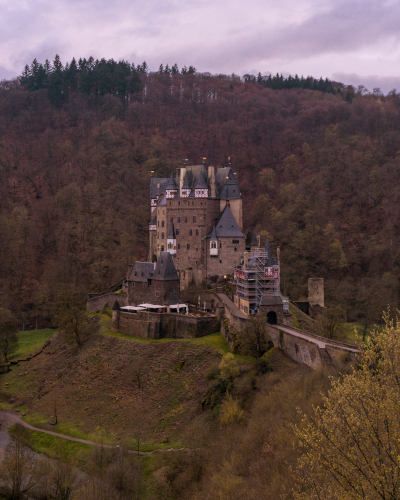
Burg Eltz
The best time to visit the Moselle Valley
Many sightseeing spots and restaurants are closed between November and March, so we’d recommend visiting the Moselle Valley between April and October. Because of summer vacations in Europe, the summer months July and August will be more crowded than the shoulder months in Spring and Autumn. We visited the Moselle Valley on the Easter weekend in April 2023. Because it was a holiday weekend, we suspected that it was more crowded than usual. It wasn’t too crowded for our taste (maybe because of the cold weather), but we explored the most crowded places like Bernkastel-Kues and Cochem in the morning, which helped. Unfortunately, the weather wasn’t really cooperating for us. With temperatures around 10 degrees Celsius it was way colder than it usually would be in April.
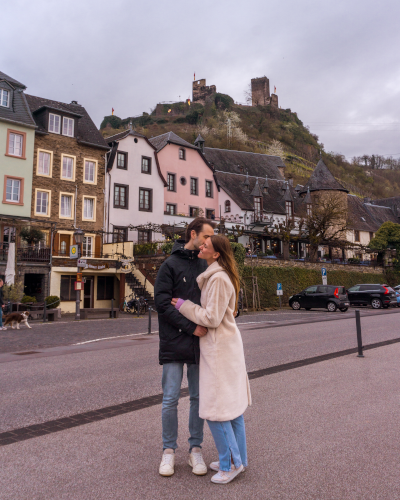
Beilstein
We hope you’ve enjoyed our guide to the best places to visit in the Moselle Valley and that our blog post inspired you to visit this beautiful area in Germany. Have you been to the Moselle Valley or is it still on your travel bucket list? Let us know in the comments below!
Be sure to check out:
- our online prints store KIPAVISTA.com
- our daily life updates on Instagram
- our YouTube Channel
- our TikTok
More Germany
The Best Things To Do in Cochem
A Complete Guide to Visiting and Photographing Burg Eltz
Where to Find the Best Cherry Blossom Spots in Hamburg

